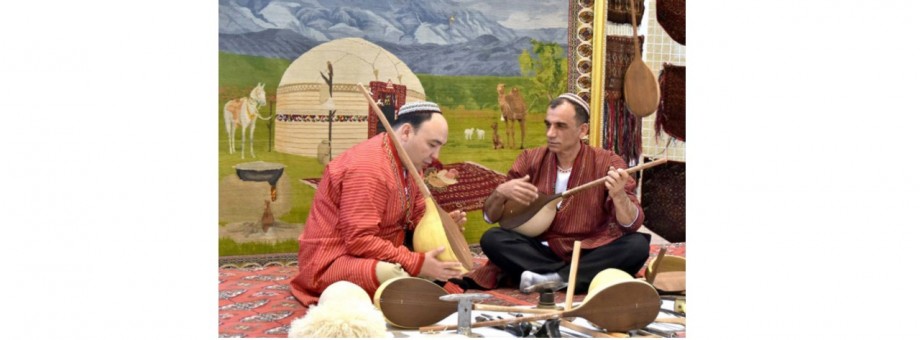THE DUTAR: THE SOUL OF TURKMENS

The dutar, which literally translates as ‘two strings’, is an integral part of the Turkmen nation’s centuries-old music. No celebration, be it a wedding or a public holiday, is complete without performances by folk musicians (bagshis).
Bagshis have always been held in great reverence and respect and their names have been the subject of legend. They themselves cherished their instruments and took tender care of them. Dutars were much treasured possessions kept in special soft fabric cases, and were never lent to anyone. There is one real-life story popular in Turkmenistan of dutar player Shukur Bagshi. It goes that once the unrivalled musician’s extraordinary performance on his dutar helped to prevent the coming fierce battle with a neighboring country.
Technically, a dutar can be made from any type of wood. But this may determine the lifespan of the instrument and directly influence its sound quality. Good quality wood is a must for a good dutar. Wood from a mulberry tree is the best choice as it makes for a light, durable instrument with a fine texture and excellent resonance. No other wood produces such a rich and distinctively unique sound. The age of wood does matter greatly. It should come from a mulberry tree which is at least 50 years old. Like a man becomes wiser over years, time makes the tree stronger, more beautiful and noble.
Making the parts fit together perfectly requires total accuracy and precise calculations. The body and top (or soundboard) of the dutar should have a standard width otherwise it will not have a great sound. Today, dutar makers (usta) take advantage of high-precision measuring instruments. But some with many years’ of professional experience make use of an ordinary ruler only like their ancestors, relying on their skill at working with wood and a keen eye for detail. When hollowing out the block of wood with a razor-sharp tool, they remove as much as required with a practiced hand. No more, no less. This fine and expert woodwork is such a fascinating sight to behold and is truly a feast for the eyes.
Work pieces are cut from the wood for future use that is well before the instrument will be made. They can be kept for decades, getting darker, almost black over time. Although the color changes, the wood quality only improves. Traditionally, Turkmen dutar luthiers use neither dyes nor varnishes as they do not make the instrument sound better or more attractive. Why to adorn? True beauty needs no adornment. All the materials should be natural like life itself. The instrument does change with age just as people do. The only difference is that people go gray as they age, while dutars turn darker.
After the wooden parts have been assembled to fit together exactly, last but not least, it remains to attach strings.
Interestingly, strings are the instrument’s only element, which is bought. The rest is handcrafted. Master dutar-makers even prefer to cast metal pegs that secure strings by themselves. By the way, the tools used by professional ustas are mostly handmade.
It is high time to test the sound quality. If the instrument does not sound good enough, the maker shaves it with a mini plane, looking for a perfect pitch and tone. To achieve this, not only should the luthier have an extraordinarily keen ear for music, but also be a gifted and technically adept musician.
Once there were associations of small-scale dutar makers in Turkmenistan. But the instruments they made were not popular and did not have ear pleasing and smooth tones. Their sounds did not penetrate and did not create a responsive vibration in the hearts of listeners. Back in the past, performers, mostly young ones, had attempted to boost and enhance dutar sounds with electrical amplification. Before too long, the idea was abandoned entirely. Apparently, the instrument is not at its best and most striking when controlled by electrical power. Dutar making should not be approached with haste and an authentic dutar cannot be mass produced, it is the result of fine and exquisite workmanship. The instrument comes to life only when the maker has put his heart and soul into it.
All dutars may seem exactly alike, but only to those who have little to do with these musical instruments. Every professional maker has his own inimitable style and is able to tell his dutar apart from thousands of others immediately. Turkmen luthiers have never put their personal marks or any identifying marks on their creations. There is no need to. The sound quality and technical excellence can help a dutar performer (bagshi) easily identify the maker.
Those who are not specialists may think that the musical instrument is too simple and plain: it has no intricate designs or ornate decorative elements. However, the external simplicity is deceptive. The dutar’s elegance, minimalist look and flowing lines have brought to perfection. Just think how extraordinarily talented and what a brilliant performer the musician should be playing melodies from his heart on the two-stringed instrument! When listening to the dutar, one can feel the heat from the scorching Turkmen sun, hear the delightful sounds of mountain rivers, the gentle lapping of waves of the ancient Caspian Sea, cries of birds flying over the endless expanse of the desert, and see the eyes and hear the whispering of two lovers in a language which only they can understand.
The art of dutar playing has never shown a sign of losing importance and has retained its widespread appeal in Turkmenistan. It has now even soared in popularity: the development of folk art receives greater attention in the country.
Vladimir Zarembo


 NEWS
NEWS